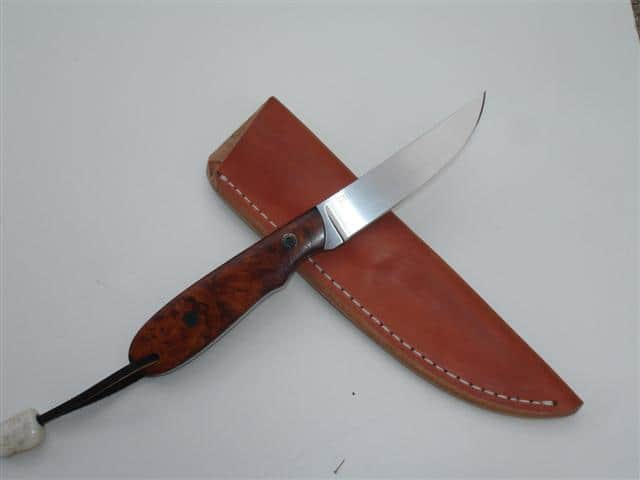Gene Ingram #4 Bird & Trout Knife
Matt Thomsen 08.31.11

Generally, my hunting buddy Scott and I are on the same page with most topics hunting. We both find a certain necessary nostalgia in a well-seasoned wall tent. You would be hard-pressed to find either of us afield absent our Badlands 2200 packs. Leupold scopes, as a rule, top every one of our hunting rifles and our feet are clad in Danner boots.
The topic of knives, however, reveals an immediate rift between his mode of thought and mine. Scott is a man with many knives. At some point pre-season, he will be found perched in front of the television with a vast array of cheap, fixed blades adorning the coffee table. Sharpening stone in hand, Scott will hone an uncountable number of blades which, invariably, find a home in a plastic storage bin. Whilst afield, a dulled knife is traded to the bin for a sharpened one. Quantity trumps quality.
Admittedly, it is a method which has worked very well for Scott. And I’d be loathe to judge either the method or the results, as I have no doubt Scott has run steel through skin on far more critters than I. That said, I subscribe to a different paradigm. I value a single, quality blade for breaking big critters down into useable pieces. And for precisely that reason, I have been using knives made by Gene Ingram for years.

My first Ingram ( a Lite Skinner) was purchased at the urging of a fellow outdoor writer. His stomping grounds primarily consisted of Alaskan bush country, so his reliance on the tools of the craft is a bit more accute than most. As such, he has always been spot on in his gear suggestions.
I am not going to go too terribly in depth regarding Gene, his knives, and the quality of both, as such a piece is an entire review in and of itself and I have already gone there. If you are curious about Gene’s background, methods, and materials, you can review my previous piece, which can be found here:
http://www.outdoorblog.net/outdoorchronicles/2011/01/31/gene-ingram-knives/
Based upon my experiences with my first Ingram blade, it wasn’t long before I picked up another. Based upon the specialized purpose of the Lite Skinner, Gene suggested I couple it with a #2 Drop Point. He was right. I really liked this particular knife as an all-around utility blade, equally at ease with gutting, quartering, and the other myriad blade tasks.

The only flaw in either of these knives was their size. While absolute perfection for breaking down bigger critters, both blades were a touch large for the smaller game the predominant amount of my time afield is spent chasing. I needed a more delicately designed blade for working on waterfowl, upland birds, and fish. I suppose I must have verbalized same, as Dad (with his ear for potential holiday gift inspiration) ordered a #4 Bird & Trout from Gene for my thirty-fifth birthday.

As the picture depicts, the #4 Bird & Trout (hereafter referenced as the B&T) is a delicate offering from Gene. It comes complete with a handmade leather sheath, leather retention thong, and polished bone guide.

The overall length of the B&T is 7.5 inches, of which 3.5 inches is blade. Blade depth is approximately three-quarters of an inch just forward of the handle. The blade material is S30V, which is the standard for all of my knives. As it comes from Gene, the edge is non-serrated and razor sharp.

The blade steel runs (as is the case in quality knives) the entirety of the length of the completed knife. It has thumb grooves to aid overall control during use.

Beautiful as polished steel can be, the true asthetic glory of this knife is found in its handle. The design is delicate without being dainty and matches the overall balance and flow of the knife perfectly. The material is premium desert ironwood. The rivets are decorative mosaics and the finish is as glossy and deep as a custom gun stock. No matter the setting, I could not get my camera to capture the entirety of the beauty of this grip. It is glorious.
Delivery of Gene’s knives is an exercise in patience. These are custom, hand-crafted offerings made one at a time by a truly skilled bladesmith. That said, they are worth the eighteen month wait.
I look foward to breaking this blade in during the upcoming months and suspect, given its pedigree, it will never let me down.

